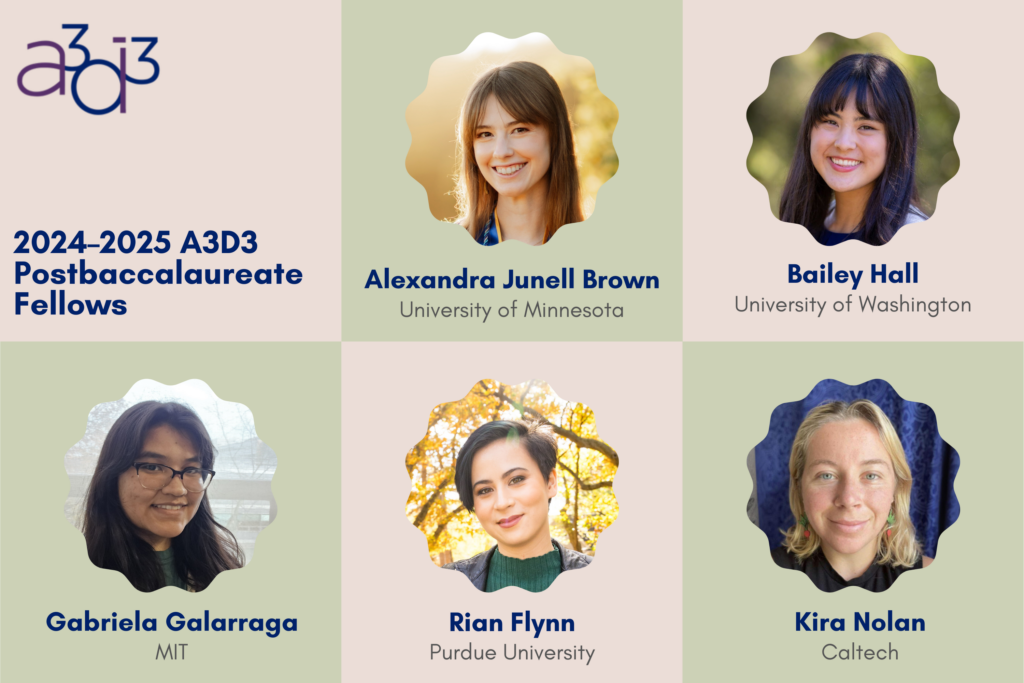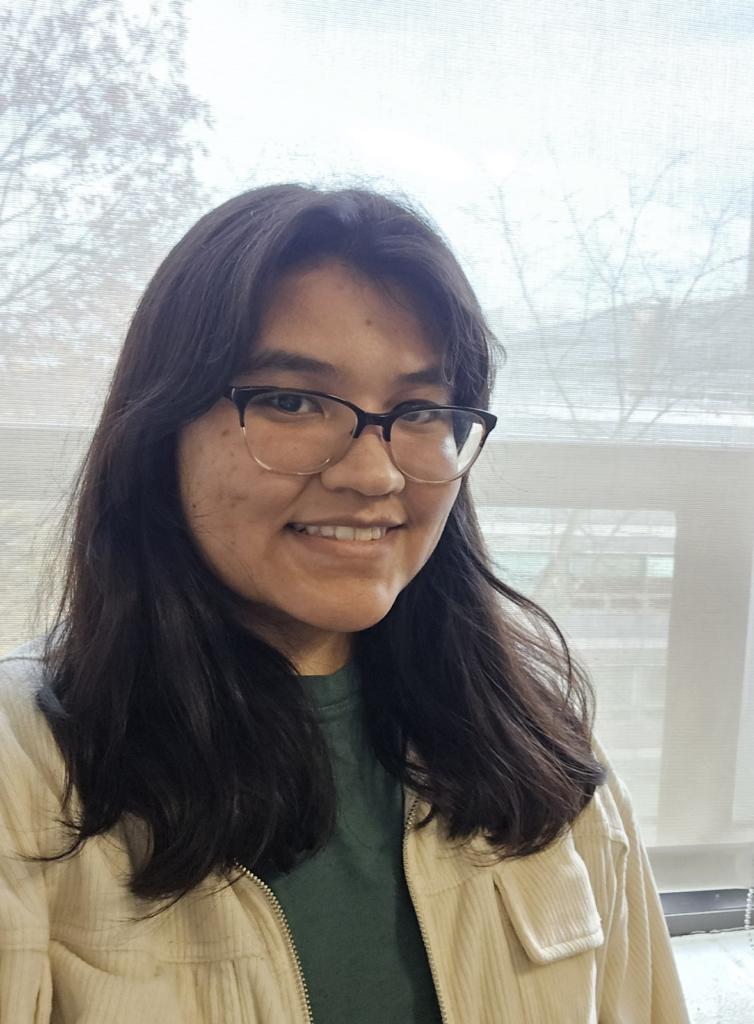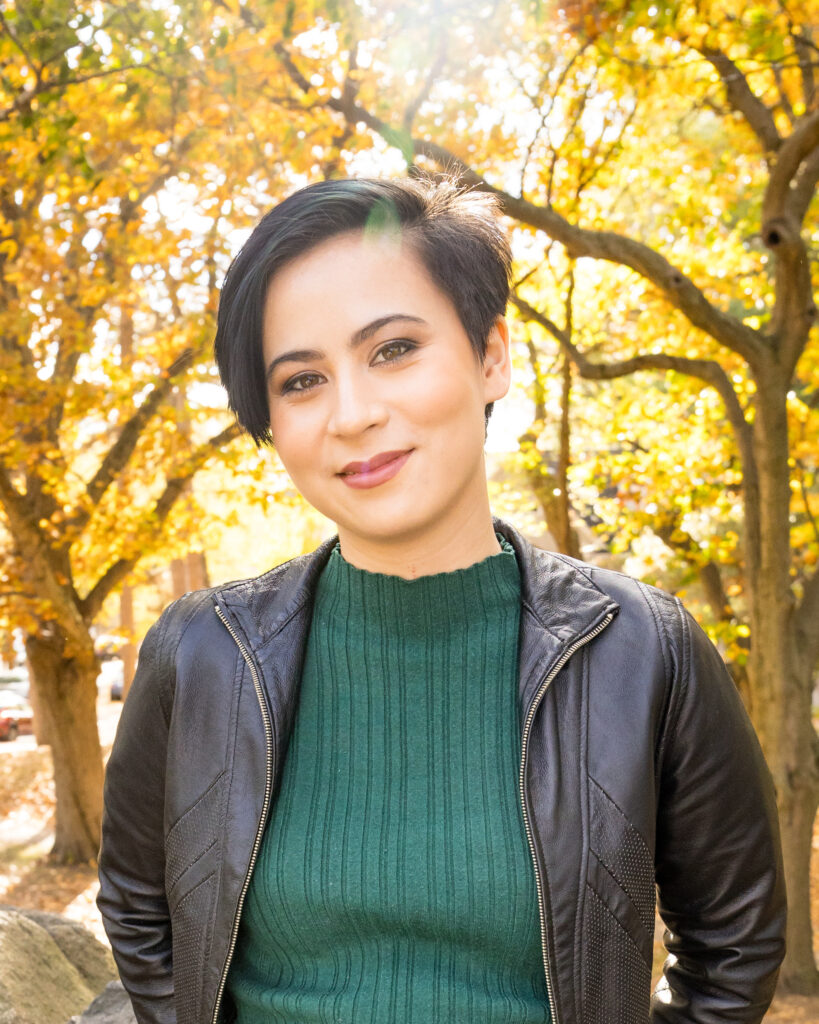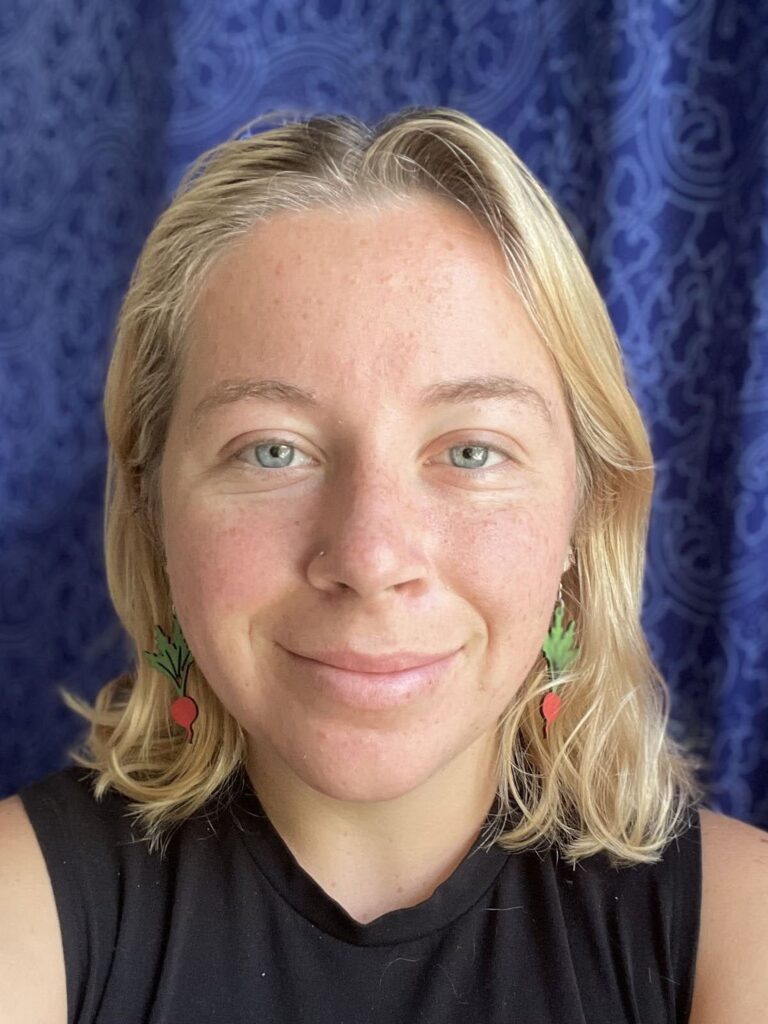Introducing the 2024–2025 A3D3 Postbaccalaureate Fellows
For the past three years, the A3D3 Postbaccalaureate Fellowship Program has provided recent college graduates in STEM with a one-year fully-funded research opportunity, serving as a bridge to graduate study or careers in industry. The program aims to increase STEM participation from historically marginalized groups.
In this post, we’d like to introduce the 2024–2025 cohort, which comprises Alexandra Junell Brown, Bailey Hall, Gabriela Galarraga, and Rian Flynn, and one of the 2023–2024 fellows, Kira Nolan, who is continuing for her second year.

Alexandra Junell Brown

Alexandra Junell (she/her), who insists you call her AJ, works with Dr. Michael Coughlin at the University of Minnesota on machine learning applications for multi-messenger astronomy. Transients are astronomical objects that temporarily change brightness on timescales ranging from seconds to years. Early classification of transients is essential for time-domain astronomers – informing candidates for follow-up observations and possibly enabling the discovery of new and rare transient phenomena. Currently, AJ is working on a multimodal, early-time classifier for transients using photometric time series data, image time series, spectra, and metadata for implementation at the Zwicky Transient Facility.
AJ graduated from the University of California, Santa Cruz, with a Bachelor of Science in physics (astrophysics) and a minor in earth science. She is a proud product of the California Community College system, first attending Orange Coast College, where she graduated with Associates in astronomy, physics, and liberal arts (to name a few). During her free time, AJ enjoys exploring the Twin Cities via Metro Transit, visiting new apple orchards, and starting (and sometimes even finishing) sewing-related projects.
Bailey Hall

Bailey Hall (she/her) graduated in May from Westmont College in Santa Barbara, California, with a Bachelor of Science in Mathematics and Data Analytics and a minor in Biblical Languages. Originally from Phoenix, Arizona, she has been enjoying Seattle’s weather since starting her postbaccalaureate position at the University of Washington in September (though people keep warning her that her enjoyment may be short-lived).
So far, Bailey has had the privilege of learning about AI applications in neuroscience from Dr. Eli Shlizerman, Dr. Hao Fang, and graduate students at UW’s NeuroAI Lab. She looks forward to beginning research with Hao Fang and others on implementing variational recurrent neural networks (vRNNs) into FPGA systems for real-time closed-loop BCI design, focusing on how Latent Factor Analysis via Dynamical Systems (LFADS) can interpret and predict neural activity data. She plans to continue her education in biostatistics or a related field, so she is grateful for this hands-on research experience.
In her free time, Bailey enjoys drawing, going on walks, discovering new coffee shops, and learning to make (but mostly eat) Korean food from her grandmother.
Gabriela Galarraga

Gabriela Galarraga (she/her) works with Prof. Phillip Harris at MIT on a high-energy physics project focused on the CMS experiment at the Large Hadron Collider (LHC). Her work involves developing and training a neural network-based algorithm to identify jets originating from bottom quarks in the CMS detector.
Gabriela graduated from the University of Colorado Boulder with a Bachelor of Arts in physics. One of her most cherished experiences during her time there was founding and building the Community of Support for Underrepresented Students (COSMOS) for students in physics, astrophysics, and engineering. In her free time, she is an avid participant in tabletop and online games, reading and crocheting granny squares.
Rian Flynn

Rian Flynn (they/them) is working with Prof. Miaoyuan Liu at Purdue University on a high-energy physics project for the Compact Muon Solenoid (CMS) experiment at the Large Hadron Collider (LHC). At the LHC, data processing and filtering must be very fast in order to handle the high volumes of data produced every second, with Field-Programmable Gate Arrays (FPGAs) used to achieve this efficiency. As machine learning plays a growing role in ensuring data from rare or new physics processes is preserved, architectures such as transformers are increasingly being explored. Rian’s project is focused on implementing efficient transformers on FPGAs to enable these low-latency high-energy physics applications.
Rian graduated from MIT with a Bachelor of Science in physics and theater arts, after which they worked as a software engineer for two years. In their free time, they enjoy songwriting, playing various instruments (guitar, violin, keyboard, and ukulele), singing, acting, and learning languages (Mandarin Chinese, Taiwanese Hokkien, Spanish, and toki pona).
Kira Nolan

Kira Nolan (she/her) works with Dr. Matthew Graham at Caltech, and is a bonus member of this cohort as she enters a second year of her postbac. This second year allows her research to align with the current observing run of the Laser Interferometer Gravitational-Wave Observatory (LIGO), which Kira uses to hunt for flares from some of the most explosive events in the universe: merging binary black holes (BBHs) and neutron stars. This work falls under the A3D3 domain of multi-messenger astronomy (MMA), which looks to combine siloed signals such as gravitational waves and electromagnetic radiation originating from the same events. Kira is looking forward to building on all that she has learned and accomplished over her first year through projects including building a fully automated pipeline for BBH follow-up, designing a reinforcement learning agent to allocate precious telescope resources in MMA scenarios, and conducting a large-scale analysis aimed at optimizing filters applied to large optical telescope data streams. She is grateful for the introduction of the two-year postbac, which matches the program’s commitment to offering a flexibility in academic pathways outside of the traditional track.
Kira graduated from Vassar College with majors in physics and astronomy and a minor in creative writing. She has lived on a series of isolated mountains post-graduation, doing science education work, including dark sky preservation outreach for the National Park Service. Now, she is happy to be in Pasadena, where she can buy coffee, go on walks with her beagle, and play rugby with the Pasadena Royals.
Edited by Rian Flynn
November 22, 2024
